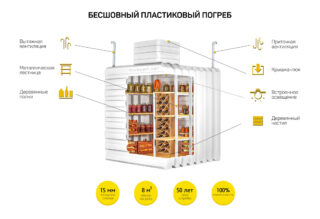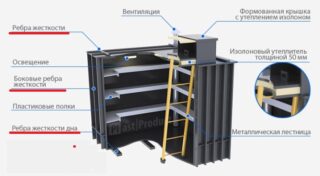The plastic capsule has advantages and disadvantages over traditional brick and concrete storage facilities. The container is made in the form of a seamless box or cylinder with external ribs for rigidity and strength. The plastic cellar for the summer cottage contains racks, shelves, lighting is carried out in it, there is a ladder for descending. The capsule is hermetically sealed and does not allow moisture to pass through.
- Description of the plastic cellar
- Polypropylene cellar device
- Features of food storage
- Types of plastic caissons
- Design advantages and disadvantages
- Criteria for choosing a plastic caisson
- Wall thickness and dimensions
- Stiffening rib
- DIY installation
- Preparation of the pit and installation of the box
- Filling the plastic box
- Thermal insulation and ventilation of the polymer capsule
- Plastic cellar problems
Description of the plastic cellar

It is a modern impervious construction, the volume of which varies depending on the needs of the consumer. The finished cellar maintains a constant internal microclimate, as a result, the shelf life of products increases.
Polypropylene in the construction of the walls is ideal for such a structure. The material has zero moisture saturation, and in combination with insulation, it keeps cool for a long time, does not freeze at subzero temperatures.
Different models take into account the area of the capsule and its operating conditions. The owners of summer cottages are attracted by the compact arrangement of the shelves, the tightness of the structure. Installation of a plastic cellar takes little time, and the service life is long.
Polypropylene cellar device
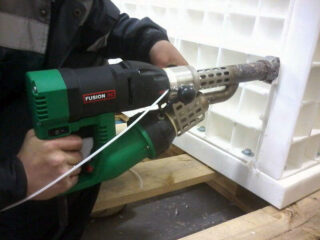
The capsule is produced by extrusion polymer welding, food-grade plastic and fiberglass are used. The design has an upper entrance hatch, or a side opening is provided. The second version of the cellar is large, but it is more convenient to use it.
Features of the structure:
- there are stiffeners on the walls and floor outside to increase the strength of the storage;
- electric cables for lighting are laid inside;
- ventilation is placed in the form of pipes at different corners of the capsule;
- air duct openings are protected by a steel mesh from rodents.
Ready-made boxes are not equipped with thermal insulation, therefore, suitable insulators are installed when installing the product. A cellar with a round bottom is considered the simplest.
Features of food storage
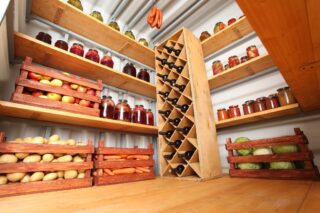
The temperature in the finished cellar for the summer cottage is kept at the level of + 2 ° - + 4 ° C, in the summer it changes slightly. There is no sunlight in the room, there is ventilation. Before storing products, vegetables are sorted out and rotten and spoiled are rejected.
Preservation conditions:
- fresh vegetables are placed separately from pickles and marinades;
- products with starting spoilage are taken out of the room;
- it is allowed to store potatoes, beets, as well as garlic and onions together;
- do not store cucumbers, tomatoes, melons for a long time.
Potatoes in a plastic box are kept until spring if they are kept in boxes. The cabbage is folded in bulk, freeing from the top green leaves. Carrots of late varieties are chosen, they are folded in layers, sprinkled with dry sand. The grapes are laid out on waxed paper, straw.
Types of plastic caissons
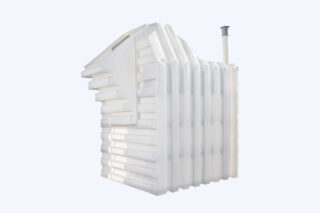
They produce prefabricated and one-piece plastic cellars made of polypropylene. The first option is purchased more often, since it is most convenient to mount it.
There are two manufacturers of underground installations on the market:
- Tinigrad. The models are designed as a seamless container. The plastic material is of high quality, ensures the resistance of surfaces to fungi, mold, microorganisms.
- Triton. The technology of welding sheet plastic is used in production, therefore, a strong and stable capsule is obtained. Corrosion and moisture absorption are completely eliminated.
Both brands guarantee a wide choice for buyers, models differ in size, service life, cost. They produce above-ground storage facilities, produce underground ones with a superstructure on the ground, and make semi-recessed options.
Design advantages and disadvantages
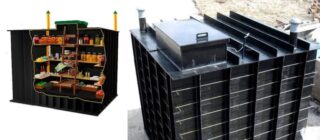
The finished plastic cellar is installed without determining the level of ground moisture. Installation of modular elements does not depend on the structure of the soil, freezing marks, which are taken into account when building brick and concrete cellars.
Positive characteristics of caissons:
- can be placed anywhere (under the summer smithy, garage, house, in an open area);
- do not respond to sudden changes in temperature and weather;
- easy installation process;
- when used correctly, plastic cellars last up to half a century.
The main drawback of the design is its high cost. You need to choose between a low price with a large and long volume of work and a significant investment in a finished cellar, which will start working in a week.
Criteria for choosing a plastic caisson
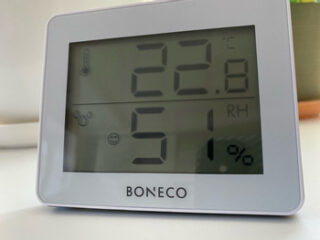
If you choose inexpensive models, there is a chance that you will get a product made from low-quality materials. When buying, you need to require documents for the caisson, the manufacturer's warranty obligations.
Pay attention to the quality of polypropylene, its compliance with environmental standards and indicators. A set of additional devices and equipment for comfortable use is taken into account. These types include various microclimate sensors, devices for adjusting shelves, the number of lamps and backlighting.
Wall thickness and dimensions
The thickness of the shell depends on the tendency of the soil to heave, therefore, a diagram of the dependence of the type of soil and the massiveness of the walls has been developed:
- if the waters do not fit in height to the base of the design location of the caisson, then the walls are chosen with a thickness of 12 - 15 mm;
- under the same conditions in dry soils that drain water well (peat bogs, sandy loam, sandy soils), select indicators of 10 mm;
- high water, a flood zone, the proximity of a natural reservoir require an increase in the thickness of the plastic walls up to 20 mm.
If the cost of the finished cellar of the required parameters exceeds the material capabilities, choose classic cellars with masonry or concreting walls.
Stiffening rib
There are two ways to install external parts:
- casting together with the capsule;
- subsequent welding.
Outer strips can contain steel rods inside for strength. Sometimes the stiffeners are placed inside the caisson, while the steel elements at the same time play the role of a frame for attaching the shelves.
DIY installation
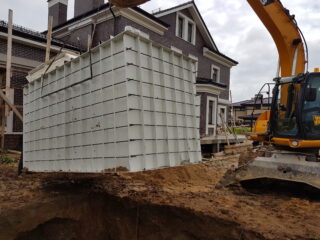
When buying, they clarify the possibility of installing a ready-made cellar by the company's specialists and whether installation is included in the cost of the structure.Usually the customer pays for the service separately, but different options are possible.
The installation can be done independently with the help of neighbors and friends, but you need to be prepared for additional costs:
- rent of an excavator for digging a pit;
- hiring a construction crane in order to lower the caisson exactly to the intended location.
Each site owner can do the work on his own if he studies the installation technology and the subtleties of the installation.
Preparation of the pit and installation of the box
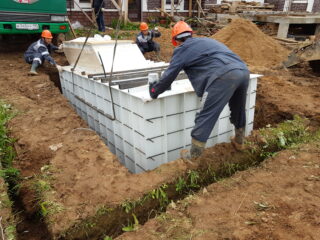
The excavation volume must exceed the dimensions of the plastic capsule. If water rises on the site, then an additional hole (50 cm deep) is dug at the bottom of the pit to collect the incoming moisture in order to work without interference.
The bottom of the pit is concreted with a layer of 220 - 250 mm. Before that, a bed of sand and crushed stone with a thickness of 100 and 200 mm is performed. Each layer is compacted with rammers. You can lay a ready-made reinforced concrete slab, which is used to overlap houses.
After laying the waterproofing, place the capsule and securely fix it with spacers, use metal slings. In the process, they control the horizontalness of the bottom of the cellar, the verticality of the walls.
Filling the plastic box
The sinuses between the side walls are poured, the soil is also poured on top of the caisson roof. Use the earth from the excavation or mix with a mixture of M 400 cement, river or quarry sand. In the second version, the mixture sets after rain and turns into a solution. After filling every 50 cm, tampers are used to compact, then the next layer is added.
In some cases, the gaps are filled with concrete. Spacers are placed inside the caisson so that the heavy mixture does not squeeze the walls inward. The filling is done in layers, 30 cm each. The next layer is placed in the gap after the previous one has set.
Thermal insulation and ventilation of the polymer capsule
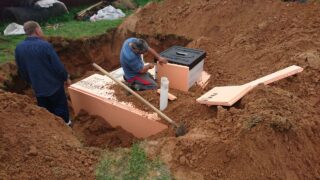
To increase protection from the cold, foam and mineral wool are used. Insulate the structure after installation and before backfilling the sinuses. Be sure to install a waterproofing membrane to reduce the effect of moisture on the insulating layer of the insulation.
Ventilation is needed to eliminate dampness and mold. The diagram includes several manifolds and vias. The main models of cellars during the manufacture are equipped with fans for forced air supply, since natural draft does not always cope with ventilation.
Plastic cellar problems
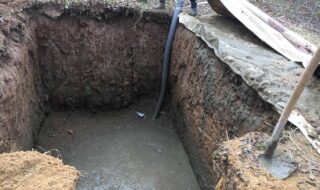
The cellar capsule can be installed in the basement of any room with the proviso that it must be installed there during the construction of the building itself. If the building has already been erected, it is impossible to put a caisson under it without dismantling the walls and floor.
Under the influence of soil moisture, which can be under pressure, the light cellar is pushed out of the ground. To exclude such movement of the structure, the base is concreted before the installation of the capsule. The monolithic plate should protrude 15 - 20 cm beyond the bottom of the container along the entire perimeter.

